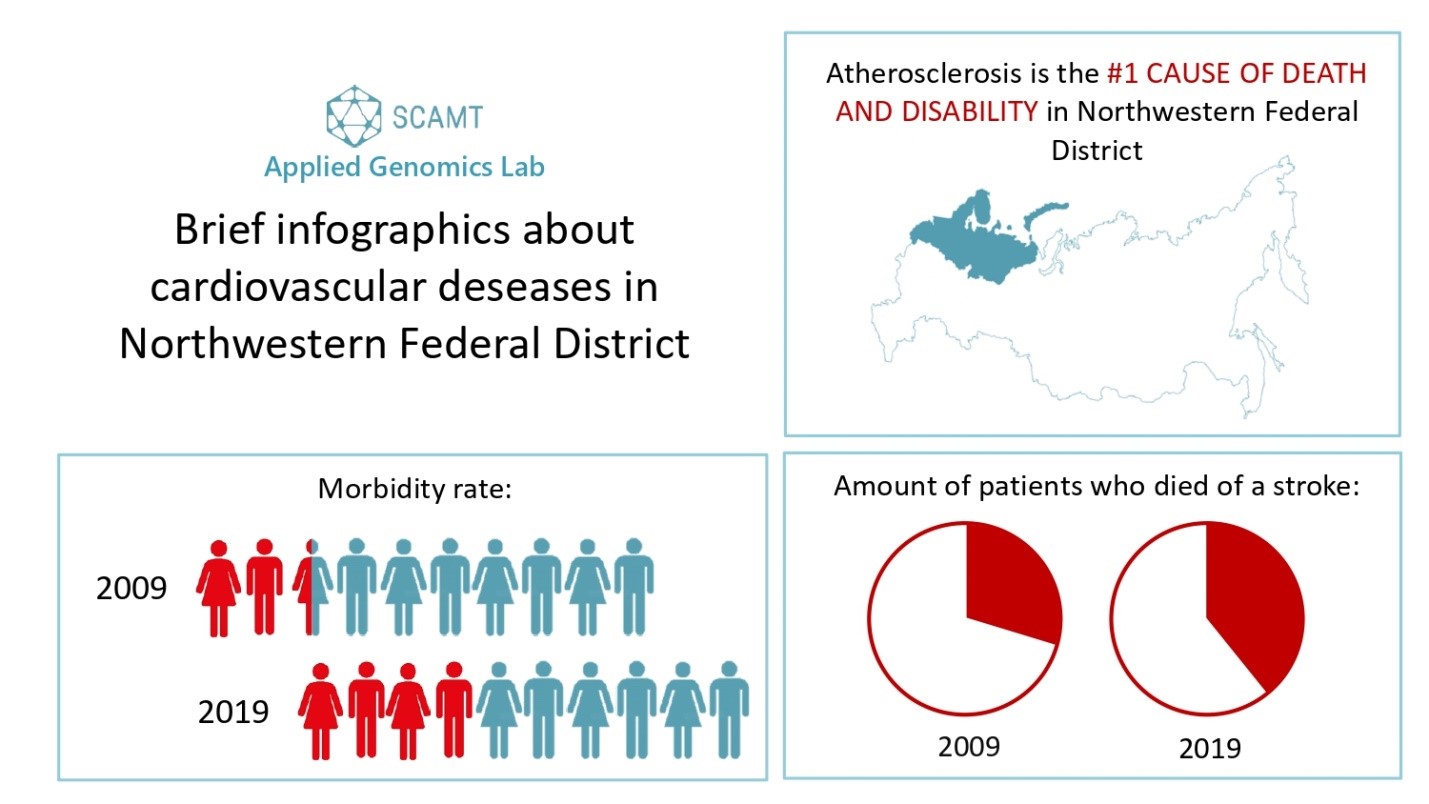Current projects of the Applied Genomics research group:
1. Comprehensive system for personalized prediction of cardiovascular disease risks.
2. Genetic diversity studies of wild populations of Siberian sturgeon (Acipenser baerii) to enhance the productivity of the respective aquaculture species.
3. Fundamental and practical aspects of Mustelidae genomics.
Comprehensive system for personalized prediction of cardiovascular disease risks

The rapid development of sequencing and bioinformatics technologies has opened up the possibility of the development of personalized approaches to the prevention, diagnosis, and treatment of diseases. A key breakthrough on the way to personalized medicine was the widespread use of Genome-wide association study (GWAS) between phenotypic traits and genomic variants. While the genetics of simple traits can often be derived from genealogy, many traits are not the result of a small number of genes that have clear, strong effects. Instead, they are a result of the complex action of thousands of weaker genetic signals. Work with traits of this kind, which interest scientists the most, has a number of problems. It turned out that it was impossible to transfer risk data from one population of people to another without significant loss of accuracy. There are three interrelated reasons for this:
1) difference in the frequencies of variants associated with risk in different populations;
2) presence of unique genetic variants for the population;
3) difference in environmental factors for different populations, such as lifestyle, nutrition and ecology.
The aim of the project is to develop an interdisciplinary approach, which considers both environmental and genetic factors, to the prediction of cardiovascular risks. The first stage of the project is to develop and implement in CMIS a questionnaire based on the successful foreign genomic projects, in particular, the UK one.
The most important point will be the opportunity to obtain new information about the phenotypic traits and environmental factors of the biobank's donors, if necessary. Based on the survey, donors will be selected for the second stage of the project: the creation of a biobank of DNA samples. The biobank will receive its own infrastructure on the basis of ITMO and Mariinsky Hospital, in addition to the existing infrastructure. Identified genetic and non-genetic markers will be used to evaluate cardiovascular disease risks.
The final goal of the project is an information system based on the Russian national Central Medical Informational System (CMIS) or similar. The system identified risks and the recommendations based on them on prevention, selection of optimal treatment, and peculiarities of the choice of drugs (pharmacogenetics) will be presented in a convenient and understandable form for the doctor and the donor patient.
The results obtained will have both applied and significant fundamental values. The developed system will significantly simplify the research on cardiovascular and other diseases, will make it possible to properly select donor groups for research, to specify the frequencies and risks of genomic variants for specific populations within the Russian population, as the frequency of the variant in the general population is the main criterion for clinical interpretation, and to find genetic variants specific to the Russian population. The result of each stage of the project (CMIS, biobank, genotypes, risks, recommendations) has a practical and fundamental application itself and can be easily expanded to other populations and/or diseases.
Genetic diversity studies of wild populations of Siberian sturgeon (Acipenser baerii) to enhance the productivity of the respective aquaculture species
Siberian sturgeon was the first sturgeon species to be commercially cultivated and is still one of the most important species for fish farming (Bronzi et al, 2011, 2014). The area of this species covers many Siberian rivers from Ob to Kolyma, but only a limited number of individuals have been introduced into Siberian sturgeon aquaculture. For a long time, almost all diversity was represented by descendants of fish from the Lena basin. Only in recent decades, they have been supplemented by herds based on individuals from the Ob and its tributaries. Despite efforts of industry to support diversity, Siberian sturgeon aquaculture shows a rapid drop in genetic diversity, which can lead to a significant drop in the adaptability of individuals to environmental conditions or even to degradation (Barmintseva et al, 2018).
Extensive monitoring of existing wildlife populations could enable the selection of individuals with the most suitable phenotypic traits for introduction into aquaculture (resistance to contamination, low oxygen content, disrupted activity cycle). Preliminary estimates on the genetic composition of populations based on mtDNA analysis indicate the existence of a hidden diversity of this species and the significant genetic potential for the creation of new and effective aquaculture.
We are already cooperating with the Laboratory of Comparative Genomics of the Institute of Molecular and Cell Biology of the Siberian Branch of the Russian Academy of Sciences (IMCB SB RAS, Novosibirsk), which has a large collection of sturgeon samples representing large basins of the Siberian rivers (Ob, Yenisei, Lena, Yana, Kolyma). Furthermore, in order to expand the existing collection, we will cooperate with the Department of Ichthyology of Tomsk State University and it will provide biological material of different fish species inhabiting the Ob basin. The study of the IMCB collection through partial and whole-genome sequencing will help to resolve any issues related to the formation and diversity of modern populations of this species. Planned data and analysis will help to improve future genetic diversity and aquaculture efficiency and provide advice on conservation work.